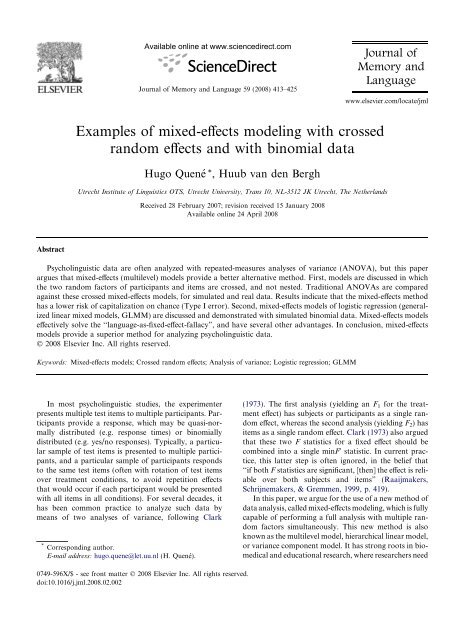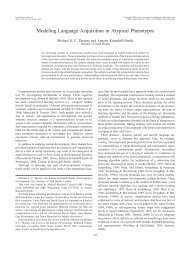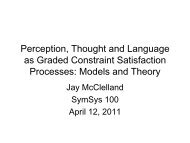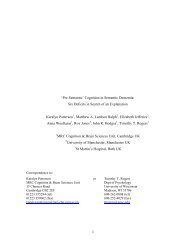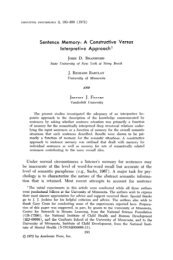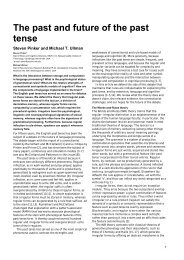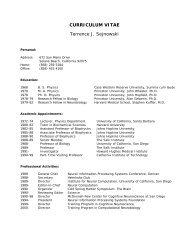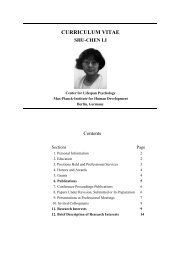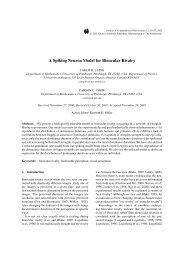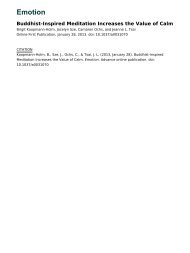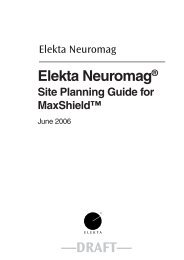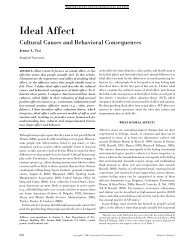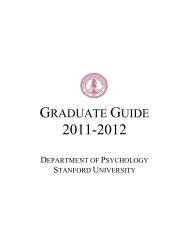Examples of mixed-effects modeling with crossed ... - Psychology
Examples of mixed-effects modeling with crossed ... - Psychology
Examples of mixed-effects modeling with crossed ... - Psychology
Create successful ePaper yourself
Turn your PDF publications into a flip-book with our unique Google optimized e-Paper software.
H. Quené, H. van den Bergh / Journal <strong>of</strong> Memory and Language 59 (2008) 413–425 415below. Finally, the <strong>mixed</strong>-<strong>effects</strong> analysis model is veryrobust against missing data, provided that data are missingat random. Hence, researchers do not need to imputemissing data <strong>with</strong> debatable imputation methods.In order to clarify the similarities and differencesamong these models, let us consider simulated data froma fictitious study into lip displacement (or some otherarticulatory parameter) which was measured under 3different articulatory conditions (here named High, Zeroand Low), <strong>with</strong> 12 repeated-measures in each condition.There were 24 participants in this fictitious study. Thedata were simulated to yield average scores <strong>of</strong> +0.2, 0,0.2 in the High, Zero and Low conditions, respectively,<strong>with</strong> variance s = 1. The data were also simulated to violateboth the sphericity assumption and the homoscedasticityassumption. In this fictitious experiment, the 12repetitions are nested under participants, allowing ahierarchical or multilevel model.In this paper, we will use two s<strong>of</strong>tware modules forestimating and reporting <strong>mixed</strong>-<strong>effects</strong> models, each <strong>with</strong>its stronger and weaker points. The oldest <strong>of</strong> these isMLwiN (Rasbash et al., 2000), an incarnation <strong>of</strong> theolder program MLn for DOS. The more recent one isthe function lmer in package lme4 (Bates, 2005). Thisis an extension package to R, an open-source packagefor statistical analysis available from http://www.r-project.org(R Development Core Team, 2008). The packagelme4 must be downloaded and installedseparately. The advantages <strong>of</strong> MLwiN are that it <strong>of</strong>fersmore flexibility in specifying the random part <strong>of</strong> themodel (and hence, in <strong>modeling</strong> heteroscedasticity andasphericity), because each term in the variance–covariancematrix can be specified explicitly, and second, thatit <strong>of</strong>fers a routine for evaluating user-defined contrasts inthe fixed part <strong>of</strong> the model (command ftest). MLwiN isonly available under Windows, however, and specifyinga model <strong>with</strong> <strong>crossed</strong> random <strong>effects</strong> is somewhat awkward.The advantages <strong>of</strong> function lmer in R are thatit is integrated in an excellent multi-platform s<strong>of</strong>twarepackage, and second, that specifying <strong>crossed</strong> randomfactors is easy and straightforward. However, testingcontrasts in the fixed part is more complicated in lmer.In the analyses reported below, the two programs’ estimatesare approximately equal. In order to familiarizereaders <strong>with</strong> <strong>mixed</strong>-<strong>effects</strong> <strong>modeling</strong>, and <strong>with</strong> thesetwo s<strong>of</strong>tware tools, annotated logs <strong>of</strong> the analyses beloware available from the first author, at http://www.let.uu.nl/~Hugo.Quene/personal/multilevel.First, we examine the variance components <strong>of</strong> the higherleveland lower-level units, by fitting an empty model thatdoes not contain any explanatory variables except for thegrand mean or intercept (Snijders & Bosker, 1999):Y ij ¼ c 00 þðu 0j þ e ij Þð3ÞThe results in Table 1 show a considerable intra-group variance<strong>of</strong> 0.277, corresponding to an intra-group correlation<strong>of</strong> 0.277/(0.277 + 0.800) = 0.27. Hence, the hierarchicalstructure should not be ignored, because doing so wouldseriously inflate the risk <strong>of</strong> a Type I error (e.g. Quené &van den Bergh, 2004; Snijders & Bosker, 1999), even ifthe intra-group correlation were as low as .05.A multivariate RM-ANOVA <strong>of</strong> the condition factor(<strong>with</strong>in subjects), carried out in SPSS, yieldsF(2,22) = 4.325, p = .026, <strong>with</strong> a reported effect sizeg 2 p¼ :282 and estimated power <strong>of</strong> .69. However, this analysisfalsely assumes that variances between subjects, andresidual variances, are homogeneous among conditions.The basic <strong>mixed</strong>-<strong>effects</strong> model in (2) contains a singlecontinuous predictor X. If the predictor is categorical,however, it is more convenient to represent the three lev-Table 1Estimated parameters (<strong>with</strong> standard error <strong>of</strong> estimate in parentheses) <strong>of</strong> <strong>mixed</strong>-<strong>effects</strong> <strong>modeling</strong> <strong>of</strong> fictitious repeated-measures dataModel (3) Model (5) Model (6) Model (7)Fixedc 00 0.023 (0.116) 0.037c H00 0.216 (0.119) 0.216 (0.136)c Z00 0.046 (0.119) 0.046 (0.108)c L00 0.191 (0.119) 0.191 (0.146)Randomr 2 u0j0.277 (0.086) 0.277 (0.086)r 2 uH0j0.415 (0.137) 0.383 (0.127)r 2 uZ0j0.221 (0.080) 0.221 (0.080)r 2 uL0j0.508 (0.163) 0.455 (0.148)r 2 eij0.800 (0.039) 0.771 (0.038) 0.696 (0.035) 0.696 (0.035)Evaluation2 log(lh) 2321.6 2290.9 2281.2 2277.2v 2 deviance(2 df) 40.4 13.7p deviance
416 H. Quené, H. van den Bergh / Journal <strong>of</strong> Memory and Language 59 (2008) 413–425els <strong>of</strong> this single factor as three dummy variables (High,Zero and Low), which have value 1 if the observationcorresponds to that condition and value 0 otherwise.In this example, we could parameterize the three conditionsas a baseline condition (Zero), and two treatmentconditions (High and Low). Hence, the model has oneterm for the baseline or intercept, and two terms forthe treatment <strong>effects</strong> (corresponding to the 2 degrees <strong>of</strong>freedom for this factor in a RM-ANOVA):Y ij ¼ c 00 þ c H00 H þ c L00 L þðu 0j þ e ij Þð4ÞInstead <strong>of</strong> this model, however, we prefer to suppressthe overall intercept c 0 , and instead include the dummyvariable for the Zero condition. The resulting coefficients,listed in Table 1, may now be interpreted directlyas estimated means per condition:Y ij ¼ c H00 H þ c Z00 Z þ c L00 L þðu 0j þ e ij Þð5ÞThe two contrasts <strong>of</strong> interest are evaluated by comparingthe estimated regression coefficients for the three dummyvariables (taking the standard error <strong>of</strong> the estimate into account).These estimates for conditions 1 and 3 (see Table 1)differ by more than two standard errors. Hence, the nullhypothesis is rejected on the basis <strong>of</strong> this significant difference.For more details on evaluation, see Faraway (2006),Goldstein (1999), Quené and van den Bergh (2004), Raudenbushand Bryk (2002), Snijders and Bosker (1999), Winer(1971). InMLwiN, the joint contrasts among the dummies’coefficients in the fixed part are evaluated by means <strong>of</strong> a v 2test statistic [here, v 2 (2) = 31.25, p < .001], much like the singleF teststatisticobtainedinaRM-ANOVA.Inusinglmer<strong>with</strong>in R, fixed <strong>effects</strong> may be tested by means <strong>of</strong> the likelihoodratio tests outlined below, or by means <strong>of</strong> the functionaovlmer.fnc in package languageR.Both the RM-ANOVA and <strong>mixed</strong>-<strong>effects</strong> modelsabove assume that the data are homoscedastic and spherical.In terms <strong>of</strong> model (5), this means that the participantsdiffer in their individual intercept values u 0j but not in theirregression coefficients c H , c Z , c L . The treatment <strong>effects</strong> areonly found in the fixed part <strong>of</strong> the model. In this data set,however, the assumptions <strong>of</strong> homoscedasticity and sphericityare both violated. The effect <strong>of</strong> treatment conditionsdiffers among participants, i.e., the variance between individualparticipants’ averages is not the same for eachtreatment condition. If predictor X were continuous, thenthe slope <strong>of</strong> X would be different among participants.This may be captured in the <strong>mixed</strong>-<strong>effects</strong> regressionmodel, by including the dummy variables also in therandom part <strong>of</strong> the model, at the higher (participant)level. We run two models, <strong>with</strong> and <strong>with</strong>out the conditionfactor in the fixed part:Y ij ¼ c 00 þðu Z0j Z þ u H0j H þ u L0j L þ e ij ÞY ij ¼ c Z00 Z þ c H00 H þ c L00 Lþðu Z0j Z þ u H0j H þ u L0j L þ e ij Þð6Þð7ÞThe estimated coefficients <strong>of</strong> model (6) (see Table 1)indicate that the between-subjects variances r 2 u0jmaynot be homogeneous among treatment conditions. Inthe final model (7), differences between conditions inthe fixed part are still significant [v 2 (2) = 9.44,p = .009], although the v 2 test statistic is considerablysmaller than in the previous model (5). The incorrectassumption <strong>of</strong> the sphericity in that model (5), i.e. ignoringthe true asphericity in the data, has greatly inflatedthe significance <strong>of</strong> the treatment effect, and may wellhave led here to capitalization on chance.Although the tables in the present paper reportstandard errors for the random estimates (followinge.g. Kreft & De Leeuw, 1998; Snijders & Bosker,1999), these are now widely regarded as unsafe forevaluating random estimates. Faraway (2006, chap.8) and Baayen, Davidson, and Bates (2008) discussseveral methods for evaluating fixed and random<strong>effects</strong>. We have chosen to evaluate random terms inthe various models by means <strong>of</strong> likelihood ratio tests,which compare the likelihood values <strong>of</strong> these models.If two models are identical in their fixed parts, andif one model is completely contained <strong>with</strong>in the other,and if both models are based on maximum likelihoodestimation, then their difference in likelihood valuesmay be evaluated by means <strong>of</strong> a v 2 distribution <strong>of</strong>the deviance (difference in likelihood), <strong>with</strong> the number<strong>of</strong> additional parameters in the more detailedmodel as the degrees <strong>of</strong> freedom (Faraway, 2006;Hox, 1995; Pinheiro & Bates, 2000; Snijders & Bosker,1999). Hence, model (6) is compared against model(3), and the final model (7) is compared against model(5), <strong>with</strong> 2 df The latter evaluation shows that thefinal model (7) fits the data significantly better thandid the predecessor model (5) [v 2 (2) = 13.7, p = .001].Because the latter <strong>mixed</strong>-<strong>effects</strong> model also capturesthe random variances due to violations <strong>of</strong> homoscedasticityand sphericity, it performs significantly betterthan an ANOVA-like model that (<strong>of</strong>ten incorrectly)assumes these violations to be absent.Crossed random <strong>effects</strong>The fictitious data analyzed in the preceding sectioncame from some hierarchical sampling design, in whichthe repeated-measures were nested <strong>with</strong>in participants;our previous tutorial (Quené & van den Bergh, 2004)was also limited to such hierarchical designs. Crucially,the repetitions were not correlated across participants.A similar multilevel, hierarchical structure is encounteredin many quasi-experimental studies, where the lower-levelunits are usually uncorrelated across higher-level units. Ina corpus study <strong>of</strong> spoken Dutch, for example, we investigatedthe speaking rate <strong>of</strong> phrases (lower-level units) thatwere spontaneously produced by speakers (higher-level
H. Quené, H. van den Bergh / Journal <strong>of</strong> Memory and Language 59 (2008) 413–425 417units) (Quené, 2008). This is a typical hierarchical samplingstructure: phrases are nested under speakers, andphrases are uncorrelated across speakers, since eachspeaker spontaneously produced an almost unique sample<strong>of</strong> phrases from the population <strong>of</strong> possible phrases.In well-controlled psycholinguistic experiments,however, the repeated observations <strong>with</strong>in the higherlevelunits (participants) are typically performed usingthe same sample <strong>of</strong> test items across participants. Interms <strong>of</strong> the experiment, this means that the observedresults may be limited to the selected test items only,and that we cannot safely generalize results to otherpossible test items (Clark, 1973). In more statisticalterms, this means that the residuals e ij in (2) are stillcorrelated, so that these errors are in fact not independent.In other words, the experimental design containstwo random <strong>effects</strong> that are <strong>crossed</strong> and not nested.There is usually only a single observation for eachcombination <strong>of</strong> participant j and test item k. Analyzingsuch data <strong>with</strong> RM-ANOVA is problematic,because RM-ANOVA allows for only one such randomeffect in its model. As proposed by Clark(1973), two independent analyses are performed, each<strong>with</strong> one random effect (either participants, yieldingF 1 , or test items, yielding F 2 ).The basic multilevel models above can be extendedto allow for multiple random <strong>effects</strong> that are <strong>crossed</strong>,and not nested (Goldstein, 1999; Snijders & Bosker,1999). Such models <strong>with</strong> <strong>crossed</strong> random <strong>effects</strong> areideally suited to analyse results from our psycholinguisticexperiments, because they allow for simultaneousand joint generalization to other participantsand to other test items. This follows from the simultaneousinclusion <strong>of</strong> both random factors into a singleanalysis. Moreover, the aforementioned general advantages<strong>of</strong> <strong>mixed</strong>-<strong>effects</strong> <strong>modeling</strong> (no assumptions <strong>of</strong>homoscedasticity nor sphericity, robustness againstmissing data, mixing discrete and continuous predictors)also apply to models <strong>with</strong> <strong>crossed</strong> random<strong>effects</strong>. In short, this type <strong>of</strong> models provides a superioralternative to the current practice <strong>of</strong> splittingthe problem into two separate RM-ANOVAs overparticipants and over items.The empty <strong>mixed</strong>-<strong>effects</strong> model for <strong>crossed</strong> random<strong>effects</strong> is given as:Y iðjkÞ ¼ c 0ð00Þ þ u 0ðj0Þ þ v 0ð0kÞ þ e iðjkÞ ð8ÞThis model contains three terms in its random part: theunique component <strong>of</strong> each participant u 0(j0) , <strong>of</strong> each testitem v 0(0k) , and the residual component e i(jk) . (The lattercorresponds to the deviation <strong>of</strong> each observation fromits predicted value.)In order to illustrate this model, let us return to thesame fictitious data analyzed before. In this section, weregard these responses as coming from a fictitious experiment<strong>with</strong> three presentation conditions (e.g. in sentencecontexts <strong>with</strong> high, neutral, and low semanticpredictability <strong>of</strong> the target word). The three conditionsconstitute a fixed factor, which varies systematicallyand not randomly, and all values <strong>of</strong> which are presentin the experiment in roughly equal proportions. A sample<strong>of</strong> 36 suitable target words was distributed over thethree conditions, <strong>with</strong> 12 target words or test items ineach condition. Items were rotated over conditions andparticipants, so that each participant responded to each<strong>of</strong> the 36 test items only once. Conversely, each test itemwas presented to 24 participants, <strong>with</strong> eight participantsin each condition, according to a latin square (yieldingan incomplete design; Cochran & Cox, 1957).This fictitious data set (identical to the one analyzedin the preceding section) was generated by assuming a<strong>crossed</strong> design, <strong>with</strong> heteroscedasticity and asphericity.This was achieved by using different variances andcovariances in the three treatment conditions at the levels<strong>of</strong> participants and <strong>of</strong> items. At the participant level,the variance–covariance matrix used in generating values<strong>of</strong> u was 4 0:245 0:300 5. At the items level,230:2000:283 0:346 0:400the single variance used in generating values <strong>of</strong> v wasr 2 v¼ 0:2 for all treatment conditions. At the residuallevel (nested under both participants and items), the variance–covariancematrix used in generating values <strong>of</strong> e230:6was 4 0:5 5. Responses were assumed to followthe normal distribution.0:4The results <strong>of</strong> the empty model (8) in Table 2 showthat the total variance in the random part is now decomposedinto three components, viz. variance between participantsr 2 u 0ðj0Þ¼ 0:288, variance between test itemsr 2 v 0ð0kÞ¼ 0:257, and residual variance nested under thecombination <strong>of</strong> participants and test itemsr 2 e iðjkÞ¼ 0:540. Since a substantial amount <strong>of</strong> the randomvariance is due to participants and to test items, both <strong>of</strong>these random variances should be included in the model.(An intra-group correlation coefficient cannot bereported here because it is not defined for models <strong>with</strong><strong>crossed</strong> random <strong>effects</strong>.)The final, optimal model contains the dummy variablesfor the three conditions in the fixed part, and alsoin the random part at the participant level:Y iðjkÞ ¼ c H H þ c N N þ c L Lþ u H0ðj0Þ H þ u N0ðj0Þ N þ u L0ðj0Þ L þ v 0ð0kÞ þ e iðjkÞð9ÞJust like model (7) above, this current optimal modelcaptures the heteroscedasticity and asphericity in thedata, and also captures random <strong>effects</strong> <strong>of</strong> participantsand <strong>of</strong> items simultaneously. This final model (9) there-
418 H. Quené, H. van den Bergh / Journal <strong>of</strong> Memory and Language 59 (2008) 413–425Table 2Estimated parameters (<strong>with</strong> standard error <strong>of</strong> estimate in parentheses) <strong>of</strong> <strong>mixed</strong>-<strong>effects</strong> <strong>modeling</strong> <strong>of</strong> fictitious data from a study <strong>with</strong>two <strong>crossed</strong> random factorsModel (8) Model (9)Fixedc 0ð00Þ 0.023 (0.141) 0.042 (0.105)c H0ð00Þ 0.216 (0.145) 0.216 (0.142)c N0ð00Þ 0.046 (0.145) 0.046 (0.137)c L0ð00Þ 0.191 (0.145) 0.191 (0.156)Randomr 2 u 0ðj0Þ0.288 (0.089) 0.289 (0.089)r 2 u H0ðj0Þ0.344 (0.114) 0.306 (0.103)r 2 u N0ðj0Þ0.264 (0.090) 0.267 (0.091)r 2 u L0ðj0Þ0.461 (0.148) 0.400 (0.130)r 2 v 0ð0kÞ0.257 (0.067) 0.258 (0.066) 0.209 (0.056) 0.212 (0.056)r 2 e iðjkÞ0.540 (0.027) 0.510 (0.025) 0.495 (0.025) 0.495 (0.025)Evaluation2 log(lh) 2080.7 2034.8 2087.0 2082.2v 2 deviance(2 df) 6.3 47.4p deviance .043
H. Quené, H. van den Bergh / Journal <strong>of</strong> Memory and Language 59 (2008) 413–425 419under H00 10 20 30 40F2(2,34)0 10 20 30 400 5 10 15 20under Ha+450 5 10 15 20F1(2,22)Fig. 1. Resulting F 1 and F 2 values <strong>of</strong> simulated data sets, <strong>with</strong> indication <strong>of</strong> significance <strong>of</strong> the fixed effect <strong>of</strong> condition, according tojoint F 1 and F 2 (open circles), minF 0 (filled circles), and <strong>crossed</strong> <strong>mixed</strong>-<strong>effects</strong> model (squares). Upper panel: <strong>with</strong>out fixed effect <strong>of</strong>condition (according to H 0 ; 500 outcomes); lower panel: <strong>with</strong> fixed effect <strong>of</strong> condition (according to H a ; showing 455 <strong>of</strong> 500 outcomes).Dashed lines indicate critical F ratios.close to the nominal a = .05. These outcomes supportthe findings <strong>of</strong> Raaijmakers et al. (1999), who arguethat the current practice <strong>of</strong> reporting only F 1 and F 2is dangerous because it inflates the risk <strong>of</strong> a Type Ierror. The present simulations confirm this inflation<strong>of</strong> Type I error. Although many researchers regardminF 0 as too conservative for comfort, these simulationssuggest that it may even be too liberal, becauseit ignores the joint correlation <strong>with</strong>in subjects and<strong>with</strong>in items. This point is further addressed below.Application to response time dataIn order to further demonstrate the <strong>mixed</strong>-<strong>effects</strong><strong>modeling</strong> <strong>with</strong> <strong>crossed</strong> random <strong>effects</strong>, we will analyzeresponse time data obtained from a phoneme monitor-
420 H. Quené, H. van den Bergh / Journal <strong>of</strong> Memory and Language 59 (2008) 413–425ing experiment. These response times were obtained in aDutch replication <strong>of</strong> the parallel English study by Quenéand Port (2005), which itself was a modification <strong>of</strong> asimilar study by Pitt and Samuel (1990). The 36 participantswere instructed to press a response button as soonas they heard a pre-specified target phoneme in a list <strong>of</strong>spoken disyllabic words (Connine & Titone, 1996). Thecritical factor was whether the word list had regular timing(isochronous intervals between stressed syllables) orirregular timing (non-isochronous intervals); fasterresponses are predicted for the regularly timed stimulias compared to the irregular-timed stimuli. The stresspattern <strong>of</strong> the target word, being either trochaeic(strong–weak) or iambic (weak–strong), constituted asecond factor in this study. As a third factor, the targetphoneme occurred either in the first or in the secondsyllable.Hence, there are three fixed <strong>effects</strong>, viz. regularity(<strong>with</strong>in items, <strong>with</strong>in participants), stress pattern, andtarget position (both varying between-items, <strong>with</strong>in-participants).For each <strong>of</strong> the four cells defined by the lattertwo factors, 24 target words were selected, <strong>with</strong> anappropriate target phoneme in the appropriate position.The 4 24 Dutch items were rotated over the presentationconditions, so that a participant heard a particulartarget words only once, yielding four different versions<strong>of</strong> the experiment (<strong>with</strong> nine participants per version).Response times were measured from the onset <strong>of</strong> the targetphoneme. The individual responses were stored inunivariate format, i.e. each row <strong>of</strong> the data file correspondsto a single response, <strong>with</strong> participant, item, factorvalues (and additional information) coded in eachrow. RTs were transformed to their logarithmic values,in order to remove the intrinsic positive skew and nonnormality<strong>of</strong> their distribution (Keene, 1995; Limpert,Stahel, & Abbt, 2001). There were 198 missing responses(6%); these were simply discarded and not imputed.As above, the preliminary <strong>mixed</strong>-<strong>effects</strong> model containsonly the intercept or ‘‘grand mean” in its fixed part.In the random part (in parentheses), the total variance isdecomposed into three components, viz. variancebetween participants r 2 u 0ðj0Þ, variance between test itemsr 2 v 0ð0kÞ, and residual variance nested under the combination<strong>of</strong> participants and test items r 2 e iðjkÞ.logðY iðjkÞ Þ¼c 0ð00Þ þ u 0ðj0Þ þ v 0ð0kÞ þ e iðjkÞð10ÞThe estimated coefficients for this model are shown inTable 3. The variance between items r 2 v 0ð0kÞis considerablylarger than the variance between participantsr 2 u 0ðj0Þ, as expected, because two <strong>of</strong> the factors <strong>of</strong> interestvary between test items. Hence, the between-items variancein the empty model reflects systematic <strong>effects</strong> underinvestigation.The next step is to include the fixed factors <strong>of</strong> interestto the model. All three factors are binary (having twolevels), and they are entered as a single dummy factor,<strong>with</strong> value 1 or ‘‘on” indicating timing being regular(hence, TR), stress falling on the second syllable (i.e., atrochee target word, hence, S2), and the target phonemebeing positioned in the second syllable (hence, P2),respectively. Because <strong>of</strong> this parameterization <strong>of</strong> termsin the model, the main effect <strong>of</strong> timing regularity modelsthis effect in the condition <strong>with</strong> trochee target words(dummy for stress equals zero) <strong>with</strong> the target phonemein the first syllable (dummy for position equals zero).Relevant two-way interactions are also included. (Thetwo-way interaction between regularity and target positionwas never significant, and it has been eliminatedhere for clarity.) The estimated coefficients are also listedin Table 3. Note that the random variance between itemsis greatly reduced, now that a considerable part <strong>of</strong> thisvariation has been captured in the fixed part <strong>of</strong> theregression model. Each main effect is significant, becauseits t value (estimate divided by standard error) evenexceeds the critical value t :95¼ 2:03 for 36 df.Next, it should be verified whether the data areindeed homoscedastic, as assumed by this regressionmodel. This was done by including each main effect intothe random part at both the levels <strong>of</strong> participants and <strong>of</strong>items, and evaluating all these candidate models bymeans <strong>of</strong> their likelihood values, as outlined above.Based on this exploration, the optimal model containsthe effect <strong>of</strong> regularity both in the fixed part and in therandom part at the items level:log Y iðjkÞ ¼ c0ð00Þ þ c TR0ð00Þ TR þ c S2 0ð00Þ S2þ c P2 0ð00Þ P2 þ c TR:S2 0ð00Þ TRS2þ c S2:P2 0ð00Þ S2P2þ u 0ðj0Þ þ v 0ð0kÞ þ v TR 0ð0kÞ TR þ e iðjkÞð11ÞThe estimated coefficients in Table 3 for this finalmodel (11) show that the main effect <strong>of</strong> regularity isno longer significant, if this effect is also included inthe random part <strong>of</strong> the model. In other words, thebetween-items variability is considerably larger in theregular-timing condition than in the irregular-timingcondition. If this heteroschadasticity is taken intoaccount, then items <strong>with</strong> initial stress do not show a significanteffect <strong>of</strong> regularity any more (due to the largerstandard error <strong>of</strong> the estimate; t = 1.79). For items<strong>with</strong> final stress, however, the regularity effect is stillhighly significant (t = 3.81). As before, we see thatameliorating the random part, to account better for randomvariation, lowers the significance levels for the fixed<strong>effects</strong>, thus reducing the risk <strong>of</strong> capitalization onchance.The results <strong>of</strong> this study involving lists <strong>of</strong> spokenwords confirm that regular speech rhythm facilitatesspoken-word perception, yielding faster reaction
Table 3Estimated parameters (<strong>with</strong> standard error <strong>of</strong> estimate in parentheses) <strong>of</strong> <strong>mixed</strong>-<strong>effects</strong> <strong>modeling</strong> <strong>of</strong> response times obtained in aphoneme monitoring experimentModel (10) Model (11)Fixedc 0ð00Þ 6.269 (0.037) 6.338 (0.036) 6.338 (0.038)c TR 0ð00Þ 0.040 (0.016) * 0.041 (0.023)c S2 0ð00Þ 0.275 (0.032) * 0.281 (0.036) *c P20ð00Þ 0.245 (0.031) * 0.245 (0.030) *c TR:S2 0ð00Þ 0.121 (0.023) * 0.121 (0.032) *c S2:P2 0ð00Þ 0.015 (0.043) 0.002 (0.042)Randomr 2 u 0ðj0Þ0.028 0.028 0.0279r 2 v 0ð0kÞ0.052 0.008 0.0149r 2 v TR 0ð0kÞ0.0121r 2 e iðjkÞ0.110 0.107 0.1035Evaluation2 log(lh) 2446 2188 2156v 2 deviance(1 df) 32p deviance
422 H. Quené, H. van den Bergh / Journal <strong>of</strong> Memory and Language 59 (2008) 413–4250.16, and 0.11. In logistic <strong>modeling</strong>, the hit rates are firstconverted to logit units [i.e. to the logarithm <strong>of</strong> the odds<strong>of</strong> hits: logitðPÞ ¼logðP=ð1 PÞÞ], which are thenregressed onto the predictors in the model. Here therespective hit rates correspond to logit values <strong>of</strong>1.174, 1.660, and 2.044, respectively. Note thatnegative logit values correspond to hit rates below .5.As before, we start by fitting the empty model.Instead <strong>of</strong> aggregating over participants, or over items,however, we model the raw hits themselves. This meansthat we can also specify a model <strong>with</strong> <strong>crossed</strong> randomfactors, i.e., the logistic equivalent <strong>of</strong> model (8):logit Y iðjkÞ¼ c0ð00Þ þ u 0ðj0Þ þ v 0ð0kÞð12ÞBecause <strong>of</strong> the computational complexities outlinedabove, it is not possible to estimate variance componentsfor residuals, as these are implied by the mean(s). Becausewe have specified <strong>crossed</strong> random factors, the intra-groupcorrelation cannot be reported. The resultingestimates are listed in Table 4.The subsequent model has the condition effect in itsfixed part only. The difference <strong>with</strong> conventional RM-ANOVA is that both participants and items are againincluded as two <strong>crossed</strong> random factors:logit Y iðjkÞ¼ cH0ð00Þ H þ c N0ð00Þ N þ c L0ð00Þ Lþ u 0ðj0Þ þ v 0ð0kÞð13ÞThe joint contrasts among the dummies’ coefficients inthe fixed part yield a significant main effect: v 2 = 14.96,p < .001, which suggests significant differences in hitrates among the three conditions. The conventionalRM-ANOVA reports a (marginally) significant main effectin both analyses [F 1 (2,22) = 3.2, p = .058;F 2 (2,34) = 6.3, p = .005] although the minF 0 value isnot significant [minF 0 (2,43) = 2.13, p = .131].As before, we verify whether the assumption <strong>of</strong>homoscedasticity is warranted, by evaluating candidatemodels having the predictors in the random part. Thisshows that the between-subject variance r 2 u 0ðj0Þvariesamong the treatment conditions, much like the originalcontinuous variable did (cf. Model (9)):logit Y iðjkÞ¼ cH0ð00Þ H þ c N0ð00Þ N þ c L0ð00Þ Lþ u H0ðj0Þ H þ u N0ðj0Þ N þ u L0ðj0Þ L þ v 0ð0kÞð14ÞThe estimated coefficients for this final model are alsolisted in Table 4. The far larger variance between participantsin the Low condition is now represented correctly inthe random part, and not in the fixed part. This results in alarger standard error (less confidence) in the estimate forthis condition in the fixed part, which in turn results inthe main effect being not significant [v 2 (2) = 4.39,p = .111]. As before, an artefactually significant effect inthe fixed part (i.e., a Type I error) has disappeared whenthe random part was ameliorated. Although the two models(13) and (14) perform equally well [as indicated by theirnon-significant deviance, v 2 (2) = 3.3, p = .192], we preferthe latter model, because it better captures the lower confidencefor very low (or very high) hit rates.Discussion and conclusionThe exposition above has demonstrated that <strong>mixed</strong><strong>effects</strong><strong>modeling</strong> provides an excellent tool for analyzingTable 4Estimated parameters (<strong>with</strong> standard error <strong>of</strong> estimate in parentheses) <strong>of</strong> <strong>mixed</strong>-<strong>effects</strong> <strong>modeling</strong> <strong>of</strong> fictitious binomial data (see text fordetails)Model (12) Model (13) Model (14)Fixedc 000 1.585 (0.256)c H000 1.174 (0.279) 1.174 (0.260)c N000 1.660 (0.290) 1.660 (0.273)c L000 2.045 (0.304) 2.045 (0.405)Randomr 2 u 0ðj0Þ0.943 (0.332) 0.968 (0.340)r 2 u H0ðj0Þ0.830 (0.380)r 2 u N0ðj0Þ0.715 (0.393)r 2 u L0ðj0Þ2.807 (1.055)r 2 v 0ð0kÞ0.642 (0.223) 0.653 (0.227) 0.612 (0.219)Evaluation2 log(lh) 652.7 611.7 615.0v 2 deviance(2 df) 3.3p deviance .192v 2 condition(2 df) n/a 14.96 4.39p condition
H. Quené, H. van den Bergh / Journal <strong>of</strong> Memory and Language 59 (2008) 413–425 423data from psycholinguistic experiments. Multiple randomfactors can be included into a single analysis, whichessentially solves the ‘‘language-as-fixed-effect-fallacy”that has plagued researchers for decades (Clark, 1973;Meuffels & van den Bergh, 2006). The multiple randomfactors can be nested (e.g. observations <strong>with</strong>in participants,for repeated-measures designs <strong>with</strong> independentobservations across participants), or they can be <strong>crossed</strong>(e.g. items and participants, for repeated-measuresdesigns where observations are also correlated acrossparticipants). Well-established techniques are availablefor <strong>modeling</strong> data that are normally distributed (perhapsafter some data transformation, as illustrated above)and for binomial data. Models for other distributionare also under current development.Only a few years ago, <strong>mixed</strong>-<strong>effects</strong> <strong>modeling</strong> was acomplicated operation requiring specialized s<strong>of</strong>tware,which <strong>of</strong>ten imposed a steep learning curve. So far thishas prevented <strong>mixed</strong>-<strong>effects</strong> <strong>modeling</strong> from becomingstandard routine in behavioral linguistic research, contraryto other disciplines. Since powerful and convenientimplementations have now become available, however,running one <strong>mixed</strong>-<strong>effects</strong> model is <strong>of</strong>ten easier than runningtwo RM-ANOVAs. Hence, there is little reason tomaintain the conventional RM-ANOVA routine <strong>of</strong>computing and combining F 1 and F 2 .The results above also indicate that <strong>mixed</strong>-<strong>effects</strong> modelsare typically more conservative than conventionalRM-ANOVA, at least for designs <strong>with</strong> <strong>crossed</strong> random<strong>effects</strong>. In our Monte Carlo simulations above, the power<strong>of</strong> the fixed effect <strong>of</strong> condition was .90 for analyses usingminF 0 , and .89 for <strong>crossed</strong> <strong>mixed</strong>-<strong>effects</strong> analyses. In otherstudies the reduction <strong>of</strong> power may not be so mild,depending on the actual experimental design, and thedegrees <strong>of</strong> heteroscedasticity, <strong>of</strong> asphericity, and <strong>of</strong>intra-group correlation (cf. Kreft & De Leeuw, 1998,chap. 5.4). [For nested designs, however, multilevel analysisseems to be more powerful than a single RM-ANOVA, Quené and van den Bergh (2004)]. The conservativebehavior <strong>of</strong> <strong>crossed</strong> <strong>mixed</strong>-<strong>effects</strong> models is neverthelessappropriate, as the following metaphorillustrates. Let us regard the data set under analysis as asponge, soaked <strong>with</strong> information. The water in the spongerepresents the variance in the data set. Our researchhypothesis is concerned <strong>with</strong> the true variance (water)related to the fixed <strong>effects</strong> in our study. Hence, we haveto squeeze out <strong>of</strong> the sponge as much <strong>of</strong> the random varianceas we can, leaving only the fixed variance <strong>with</strong>in thesponge, and we catch that squeezed-out random variancein a bucket. In RM-ANOVA, we are limited to use onlyone hand for squeezing. So, we squeeze <strong>with</strong> the righthand (yielding F 1 ), we take an exact copy <strong>of</strong> the soakedsponge, and we squeeze that <strong>with</strong> the left hand (yieldingF 2 ). In both squeezes, however, some amount <strong>of</strong> randomvariance (water) is inadvertedly left in the sponge, becausesqueezing can only be done imperfectly <strong>with</strong> a single hand.In both analyses, this remaining random variance weighsin <strong>with</strong> the fixed-effect variance in the sponge, instead <strong>of</strong><strong>with</strong> the random variance in the bucket. Hence, to mixmetaphors, it inflates the significance <strong>of</strong> the fixed effect,and may result in a false positive outcome, or Type I error.In <strong>mixed</strong>-<strong>effects</strong> <strong>modeling</strong>, by contrast, we use both handsfor squeezing. This allows us to squeeze more random variance(water) out <strong>of</strong> the sponge. After squeezing, theamount <strong>of</strong> variance (water) <strong>with</strong>in the sponge is smaller,and the amount in the bucket is larger, because <strong>of</strong> ourmore effective two-handed squeezing. Because theamount <strong>of</strong> random variance (water) that is left in thesponge instead <strong>of</strong> the bucket is now smaller, the evaluation<strong>of</strong> the fixed <strong>effects</strong> will be better. The less liberalbehavior <strong>of</strong> <strong>mixed</strong>-<strong>effects</strong> analysis, relative to minF 0 analyses,provides a better protection against capitalization onchance.If the language items under study (e.g. target words)are regarded as a random sample from a larger population<strong>of</strong> these items, i.e. as a random effect, then <strong>crossed</strong> <strong>mixed</strong><strong>effects</strong>models effectively solve the ‘‘language-as-fixed<strong>effects</strong>-fallacy”,as argued before. However, includingitems as a random effect in a <strong>crossed</strong> <strong>mixed</strong>-<strong>effects</strong> modeldoes not in itself provide information about the generality<strong>of</strong> the fixed effect(s) over these items (as noted by LeonardKatz in the internet-based debate about F 2 ; see Forster,this issue, for an introduction). Such a measure <strong>of</strong> generalitywould even go against this model, precisely becauseitems are assumed to be randomly selected, and hence,as essentially homogeneous in their susceptibility to thefixed effect. Moreover, an interaction <strong>of</strong> items by treatmentscannot be evaluated in an incomplete design suchas the latin-square designs discussed here. Unless all combinations<strong>of</strong> subjects and items are tested under all treatmentconditions, the two-way interactions <strong>of</strong> items bytreatments and <strong>of</strong> subjects by treatments are confounded<strong>with</strong> the main effect <strong>of</strong> treatment (Bailey, 1982; Cox, 1958;Janse & Quené, 2004). What analysts can do, however, isinspect and compare the residuals <strong>of</strong> the items (cf. Afshartous& Wolf, 2007), and attempt to relate these to somerelevant property <strong>of</strong> the items. This property (e.g. part<strong>of</strong> speech, lexical frequency, etc.) may then be includedas a tentative fixed between-item predictor in their candidatemodels, and it may be tested for its main effect and forinteractions <strong>with</strong> the fixed treatment <strong>effects</strong> under study.In an educational analogy, we can evaluate the fixed effect<strong>of</strong> treatment on students’ performance, but we cannotevaluate the interaction <strong>of</strong> treatment and students, if studentswere indeed sampled at random. Relevant properties<strong>of</strong> the students, e.g. IQ score, may however be usedas additional fixed predictors <strong>of</strong> the treatment effect, and<strong>of</strong> the variation in students’ individual intercepts and instudents’ slopes <strong>of</strong> the treatment effect.Mixed-<strong>effects</strong> <strong>modeling</strong> thus <strong>of</strong>fers considerableadvantages over RM-ANOVA techniques, as discussedabove. This technique also allows researchers to com-
424 H. Quené, H. van den Bergh / Journal <strong>of</strong> Memory and Language 59 (2008) 413–425bine discrete and categorical predictors into a singlemodel, it does not require homoscedasticity nor sphericity,it does not require aggregation <strong>of</strong> binomial data, andit is robust against missing data. In conclusion, <strong>mixed</strong><strong>effects</strong><strong>modeling</strong> provides a superior means <strong>of</strong> statisticalanalyses in our discipline, and adopting this technique ishighly recommended to improve our research into languageand speech behavior.AcknowledgmentsHugo Quené and Huub van den Bergh, Utrecht institute<strong>of</strong> Linguistics OTS, Utrecht University.Our thanks are due to Douglas Bates for technicalassistance, to Esther Janse and Sieb Nooteboom forhelpful discussions, and to Tom Lentz, Harald Baayenand two anonymous reviewers for valuable commentsand suggestions.ReferencesAfshartous, D., & Wolf, M. (2007). Avoiding ‘data snooping’ inmultilevel and <strong>mixed</strong> <strong>effects</strong> models. Journal <strong>of</strong> the RoyalStatistical Society Series A (Statistics in Society), 170(4),1035–1059.Baayen, R. H., Davidson, D. J., & Bates, D. M. (2008). Mixed<strong>effects</strong> <strong>modeling</strong> <strong>with</strong> <strong>crossed</strong> random <strong>effects</strong> for subjectsand items. Journal <strong>of</strong> Memory and Language, 59, 390–412.Baayen, R. H., Tweedie, F. J., & Schreuder, R. (2002). Thesubjects as a simple random effect fallacy: Subject variabilityand morphological family <strong>effects</strong> in the mental lexicon.Brain and Language, 81(1–3), 55–65.Bailey, R. (1982). Confounding. In N. Johnson & S. Kotz(Eds.). Encyclopedia <strong>of</strong> statistical sciences (Vol. 2,pp. 128–134). New York: Wiley.Bates, D. (2005). Fitting linear models in R: Using the lme4package. R News, 5(1), 27–30.Clark, H. (1973). The language-as-fixed-effect fallacy: A critique<strong>of</strong> language statistics in psychological research. Journal <strong>of</strong>Verbal Learning and Verbal Behavior, 12, 335–359.Cnaan, A., Laird, N. M., & Slasor, P. (1997). Using the generallinear <strong>mixed</strong> model to analyse unbalanced repeated measuresand longitudinal data. Statistics in Medicine, 16(20),2349–2380.Cochran, W., & Cox, G. (1957). Experimental designs. NewYork: Wiley.Connine, C. M., & Titone, D. (1996). Phoneme monitoring.Language and Cognitive Processes, 11(6), 635–645.Cox, D. (1958). Planning <strong>of</strong> experiments. New York: Wiley.Faraway, J. J. (2006). Extending the linear model <strong>with</strong> R:Generalized linear, <strong>mixed</strong> <strong>effects</strong> and nonparametric regressionmodels. Boca Raton, FL: Chapman and Hall.Goldstein, H. (1999). Multilevel statistical models (2nd (electronicupdate) ed.). London: Edward Arnold.Guo, G., & Zhao, H. (2000). Multilevel <strong>modeling</strong> for binarydata. Annual Review <strong>of</strong> Sociology, 26, 441–462.H<strong>of</strong>fmann, L., & Rovine, M. J. (2007). Multilevel models forthe experimental psychologist: Foundations and illustrativeexamples. Behavior Research Methods, 39(1), 101–117.Hosmer, D. W., & Lemeshow, S. (2000). Applied logisticregression (2nd ed.). New York: Wiley.Hox, J. (1995). Applied multilevel analysis. Amsterdam: TTPublicaties.Janse, E., & Quené, H. (2004). On measuring multiple lexicalactivation using the cross-modal semantic priming technique.In H. Quené & V. J. van Heuven (Eds.), On speechand language: Studies for Sieb G. Nooteboom (pp. 105–114).Utrecht: LOT.Keene, O. N. (1995). The log transformation is special.Statistics in Medicine, 14, 811–819.Kleinbaum, D. G. (1992). Logistic regression: A self-learningtext. New York: Springer.Kreft, I. G., & De Leeuw, J. (1998). Introducing multilevel<strong>modeling</strong>. London: Sage.Limpert, E., Stahel, W. A., & Abbt, M. (2001). Lognormaldistributions across the sciences: Keys and clues. Bioscience,51(5), 341–352.Luke, D. A. (2004). Multilevel <strong>modeling</strong>. Thousand Oaks, CA:Sage.Maxwell, S. E., & Delaney, H. D. (2004). Designing experimentsand analyzing data: A model comparison perspective (2nded.). Mahwah, NJ: Lawrence Erlbaum Associates.Meuffels, B., & van den Bergh, H. (2006). De ene tekst is deandere niet: The language-as-fixed-effect fallacy revisited:Statistische implicaties. Tijdschrift voor Taalbeheersing,28(4), 323–345.O’Brien, R. G., & Kaiser, M. K. (1985). MANOVA method foranalyzing repeated measures designs: An extensive primer.Psychological Bulletin, 97(2), 316–333.Pampel, F. C. (2000). Logistic regression: A primer. ThousandOaks, CA: Sage.Pinheiro, J. C., & Bates, D. M. (2000). Mixed-<strong>effects</strong> models in Sand S-Plus. New York: Springer.Pitt, M. A., & Samuel, A. G. (1990). The use <strong>of</strong> rhythm inattending to speech. Journal <strong>of</strong> Experimental <strong>Psychology</strong>:Human Perception and Performance, 16(3), 564–573.Pollatsek, A., & Well, A. D. (1995). On the use <strong>of</strong> counterbalanceddesigns in cognitive research: A suggestion for abetter and more powerful analysis. Journal <strong>of</strong> Experimental<strong>Psychology</strong>: Learning, Memory, and Cognition, 21(3),785–794.Quené, H. (2008). Multilevel <strong>modeling</strong> <strong>of</strong> between-speaker and<strong>with</strong>in-speaker variation in spontaneous speech tempo.Journal <strong>of</strong> the Acoustical Society <strong>of</strong> America, 123(2),1104–1113.Quené, H., & Port, R. (2005). Effects <strong>of</strong> timing regularity andmetrical expectancy on spoken-word perception. Phonetica,62(1), 1–13.Quené, H., & van den Bergh, H. (2004). On multi-level<strong>modeling</strong> <strong>of</strong> data from repeated measures designs: Atutorial. Speech Communication, 43(1–2), 103–121.R Development Core Team. (2008). R: A language andenvironment for statistical computing. R Foundation forStatistical Computing. [Computer program (version 2.6.2)].Available from: http://www.r-project.org.Raaijmakers, J. G., Schrijnemakers, J. M., & Gremmen, F.(1999). How to deal <strong>with</strong> ‘‘the language-as-fixed-effect
H. Quené, H. van den Bergh / Journal <strong>of</strong> Memory and Language 59 (2008) 413–425 425fallacy”: Common misconceptions and alternative solutions.Journal <strong>of</strong> Memory and Language, 41, 416–426.Rasbash, J., Browne, W., Goldstein, H., Yang, M., Plewis, I.,Healy, M., et al. (2000). A user’s guide to MLwiN(Computer program (version 2.02) and manual. Availablefrom: http://www.cmm.bristol.ac.uk/team/userman.pdf).Multilevel Models Project, Institute <strong>of</strong> Education, University<strong>of</strong> London.Raudenbush, S. W., & Bryk, A. S. (2002). Hierarchical linearmodels: Applications and data analysis methods (2nd ed.).Thousand Oaks, CA: Sage.Richter, T. (2006). What is wrong <strong>with</strong> ANOVA andmultiple regression? Analyzing sentence reading times<strong>with</strong> hierarchical linear models. Discourse Processes,41(3), 221–250.Rietveld, T., & Van Hout, R. (2005). Statistics in languageresearch: Analysis <strong>of</strong> variance. Berlin: Mouton de Gruyter.Searle, S. R., Casella, G., & McCulloch, C. E. (1992). Variancecomponents. New York: Wiley.Snijders, T., & Bosker, R. (1999). Multilevel analysis: Anintroduction to basic and advanced multilevel <strong>modeling</strong>.London: Sage.van der Leeden, R. (1998). Multilevel analysis <strong>of</strong> repeatedmeasures data. Quality and Quantity, 32, 15–19.Winer, B. (1971). Statistical principles in experimental design(2nd ed.). New York: McGraw-Hill.


